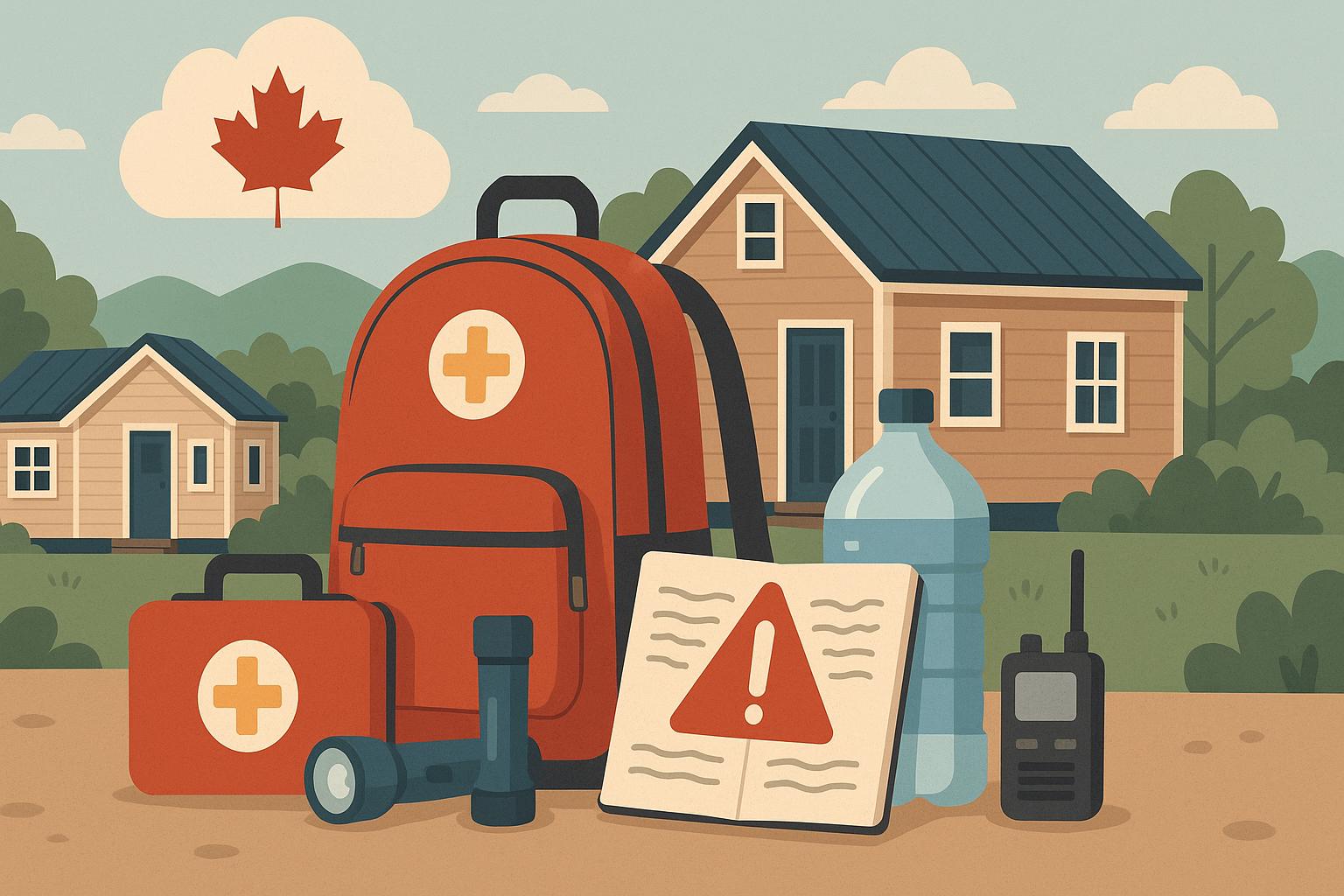
Estimated reading time: 10 minutes
Tiny Home Emergency Preparedness Canada: A Comprehensive Guide for Tiny Home & ADU Residents
Key Takeaways
- Introduction to Emergency Preparedness: Understand why tiny home and ADU residents in Canada must plan for hazards like wildfires, floods, winter storms, and power outages.
- Regional Hazards: Insight into how dangers differ in regions such as British Columbia, Quebec, Ontario, and nationwide concerns.
- Actionable Strategies: Step-by-step tips on disaster planning, compact emergency kit creation, and routine safety checks.
- Community Engagement: Building networks and using local resources to enhance overall preparedness.
Table of contents
- Introduction: Why Tiny Home Emergency Preparedness Canada Matters
- Canadian Hazards Relevant to Tiny Homes and ADUs
- Key Principles of Emergency Preparedness for Tiny Homes and ADUs
- Safety Considerations Specific to Tiny Homes and ADUs
- Practical Emergency Preparedness Strategies
- Integrating Disaster Planning into Daily Tiny Home Living
- Community and Local Resources for Emergency Preparedness
- Conclusion & Call to Action
- Frequently Asked Questions
Introduction: Why Tiny Home Emergency Preparedness Canada Matters
Tiny homes and Accessory Dwelling Units (ADUs) offer affordability and energy efficiency, but their compact nature demands a unique approach to emergency preparedness. With limited space and lighter construction materials, planning for emergencies such as wildfires, floods, winter storms, and power outages is crucial.
Across Canada, hazards like wildfires in British Columbia, floods in Quebec and Ontario, and severe winter storms pose real threats to these dwellings. Adopting customized emergency strategies not only protects your belongings but also the wellbeing of all residents.
For further insight, refer to
Tiny House Design & Safety,
Flood Preparedness in Canada, and
Severe Weather & Emergency Prep.
Canadian Hazards Relevant to Tiny Homes and ADUs
Wildfires in British Columbia
Wildfires can spread rapidly in British Columbia’s forests and grasslands. Tiny homes and ADUs, with their compact layouts and combustible materials, may face delayed emergency response in rural clusters.
- Wildfire smoke and poor air quality increase health risks.
- Mobile homes may require urgent evacuations when roads are blocked.
Source: Tiny House Design & Safety and
Wildfire Resistant Tiny Homes.
Flood Risks in Quebec and Ontario: Disaster Planning Critical
Flooding is a major concern in Quebec and Ontario due to:
- Lack of raised or flood-resistant foundations.
- Inadequate waterproofing and limited evacuation time during sudden rises.
- Few advanced drainage systems like sump pumps are installed.
Sources: Severe Weather & Emergency Prep,
Flood Preparedness in Canada,
Flood Zone Construction, and
Flood Resistant ADU Design.
Winter Storms Across Canada: The Need for Emergency Preparedness
Heavy winter storms across Canada bring risks such as lightweight roofs failing under snow/ice, dangerous power outages, and isolation of rural tiny homes.
Sources: Severe Weather & Emergency Prep,
Canadian Snow Load Requirements, and
Winter Proof Tiny Home.
Regional Hazards Summary Table
| Region | Prevalent Hazard | Tiny Home/ADU Impact |
|---|---|---|
| British Columbia | Wildfires | Rapid fire spread, intense heat, urgent evacuation needs |
| Quebec/Ontario | Flooding | Risk of water infiltration and limited evacuation time |
| Nationwide | Winter Storms | Snow/ice damage, power loss, isolation, urgent heating concerns |
For detailed insights, revisit
Tiny House Design & Safety,
Flood Preparedness in Canada, and
Emergency Weather Canada.
Key Principles of Emergency Preparedness for Tiny Homes and ADUs
Disaster Planning for Small Spaces
Good disaster planning is essential for all dwellings, particularly for tiny homes and ADUs. Tailor your plan by:
- Escape Routes: Establish clear, unobstructed exit paths and practice regular drills.
- Custom Emergency Protocols: Adhere to local municipal guidelines—BC emphasizes wildfire evacuation while Ontario/Quebec focus on floods.
- Compact Space Adaptation: Organize emergency supplies with labelled storage solutions.
- Plan for Every Scenario: Incorporate both shelter-in-place and evacuation strategies, updating them seasonally.
Sources:
Flood Preparedness in Canada,
Tiny House Design & Safety, and
Emergency Preparedness Disaster Planning.
Hazard-Specific Emergency Plans for Tiny Home Safety
Fire Safety: Ensure multiple smoke and carbon monoxide detectors are installed. Use fire-rated materials and keep fire extinguishers within reach.
Source: Tiny House Design & Safety and
Tiny Home Fire Safety.
Flood Response: Elevate storage, map evacuation routes, and utilize waterproof containers for essential documents.
Source: Flood Preparedness in Canada and
Flood Preparedness Guide.
Power Outages: Stock battery-powered radios, LED flashlights, extra batteries, and consider solar or generator solutions.
Source: Severe Weather & Emergency Prep and
Power Outage Preparedness Tips.
Communication Plans for Emergency Preparedness
In the face of disaster, communication is vital. Maintain hard copies of emergency contacts in waterproof containers, and designate meeting points outside your local area. Regularly review and update these plans.
Source: Flood Preparedness in Canada and
Communication Emergency Preparedness.
Safety Considerations Specific to Tiny Homes and ADUs
Structural Integrity and Canadian Hazards
Ensuring structural integrity is vital. Verify your building materials comply with Canadian codes to withstand local hazards:
- Secure roofs for heavy snow and ice loads.
- Reinforce frames with hurricane or seismic ties where needed.
- Anchor mobile homes and ADUs adequately to prevent movement during storms or floods.
Source: Tiny House Design & Safety and
Steel Framed Small Homes.
Fire Safety, Emergency Exits, and ADU Safety Tips
Best practices for safety include the placement of detectors, use of certified heating appliances, fire-rated materials around heat sources, and ensuring each living area has at least two accessible emergency exits.
Source: Tiny House Design & Safety and
Tiny Home Fire Safety.
Ventilation and Placement of Safety Devices
- Install CO alarms in all sleeping areas and maintain clear vents.
- Mount fire extinguishers near exits, kitchens, and heating sources.
- Keep first aid kits and emergency supplies in accessible, labelled storage.
Sources:
Tiny House Design & Safety,
Flood Preparedness in Canada, and
Emergency Supplies for Tiny Homes.
Practical Emergency Preparedness Strategies
Creating Compact Emergency Supply Kits
In tiny spaces, every item counts. A compact emergency kit should include:
- Water: At least 2–4 litres per person per day in stackable or collapsible containers.
- Food: Energy-dense, non-perishable items such as granola bars, canned beans, and nuts paired with a manual can opener.
- First Aid Kit: Basic medications, bandages, antiseptics, tweezers, thermal blankets, and gloves.
- Lighting & Power: Battery-powered/wind-up radios, LED flashlights, spare batteries, and solar chargers if available.
- Multipurpose Storage: Use wall-mounted or under-bed totes to maximize space.
Source: Severe Weather & Emergency Prep and
Compact Emergency Kits for Tiny Homes.
Seasonal and Location-Specific Preparation for Canadian Hazards
Canadian winters require extra attention. Equip your kit with insulated clothing, thermal blankets, ice melt, snow shovels, and pipe insulation. Regularly check and rotate supplies, including jumper cables and traction aids.
Source: Severe Weather & Emergency Prep and
Winter Preparedness for Tiny Homes.
Integrating Disaster Planning into Daily Tiny Home Living
Routine Maintenance and Safety Checks
Incorporate emergency preparedness into your daily routine by:
- Testing smoke and CO detectors monthly and replacing batteries bi-annually.
- Keeping all escape routes clear and inspecting heating systems before winter.
- Cleaning gutters and removing external debris to reduce fire hazards.
Sources: Tiny House Design & Safety and
Flood Preparedness in Canada.
Regular Drills and Updates
Conduct annual safety drills covering fire, flood, evacuation, and blackout scenarios. Review and update your emergency maps and kits whenever changes occur in your living space.
Digital Backup: Keep electronic copies of important documents on a secure USB drive or encrypted SD card stored with your emergency kit.
Source: Severe Weather & Emergency Prep and
Digital Emergency Preparedness.
Community and Local Resources for Emergency Preparedness
Leveraging Canadian Hazards Response Systems
In times of crisis, connecting with external resources is vital. Register for municipal emergency alert services and rely on organizations like the Red Cross and provincial disaster services.
Sources: Severe Weather & Emergency Prep and
Flood Preparedness in Canada.
Building a Support Network
Connect with local and online communities of tiny home and ADU residents. Establish a network of neighbours who can assist during emergencies and share real-time updates.
Identifying Local Shelters
Before disaster season, locate nearby emergency shelters and note their capacity, pet policies, and accessibility. Integrate these options into your evacuation plan.
Source: Severe Weather & Emergency Prep and
Emergency Shelters in Canada.
Conclusion & Call to Action
Proactive tiny home emergency preparedness Canada is essential to protect your home, belongings, and family. Recognize and plan for Canadian hazards—wildfires, floods, winter storms, and power outages—by creating solid emergency plans, maintaining regular safety routines, and connecting with your community.
Take action today: update your emergency plans, organize accessible safety supplies, and engage with local resources and shelters. For more detailed guidance, consult
Tiny House Design & Safety,
Severe Weather & Emergency Prep, and
Flood Preparedness in Canada.
By integrating these tips into your daily life, you ensure a safer future for you and your community. Don’t wait—start building your emergency preparedness plan today.
Frequently Asked Questions
-
Q: How do I start planning my emergency kit in a tiny home?
A: Begin by assessing your space, prioritizing compact, multi-use items such as water, non-perishable food, and essential medical supplies. Regularly update your kit and practice your evacuation plan.
-
Q: What are the main hazards for tiny homes in Canada?
A: The primary concerns include wildfires (especially in BC), flooding (Quebec/Ontario), severe winter storms, and power outages.
-
Q: How often should emergency drills be conducted?
A: Ideally, conduct drills at least once a year and update your emergency plans whenever there are changes in your living arrangements or local infrastructure.

Leave a Reply